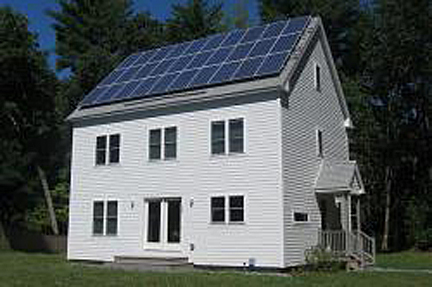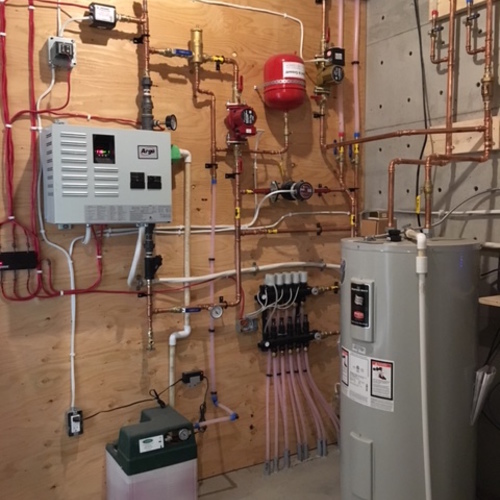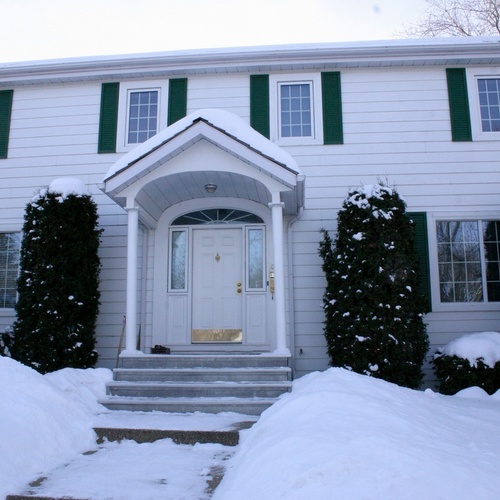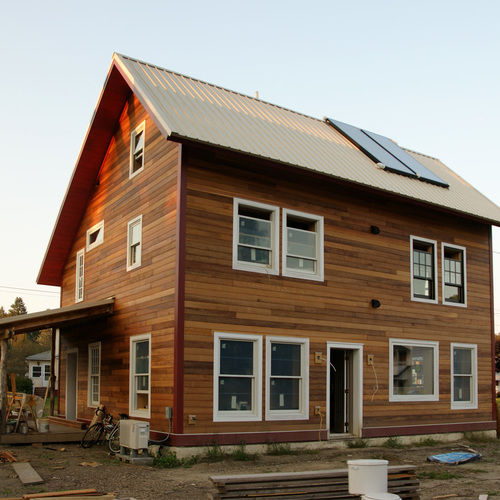
Summers in Massachusetts are easy in comparison to winters. Some people (myself included — a bit) saw air conditioning as the devil or something.
I’m not sure why. When it’s 98°F outside, and 78°F inside (a typical setting) — especially if you live in a house with three times as much insulation as a typical new house — it takes hardly any energy to cool the place. The temperature differential between inside and outside is only 20 F°. And the house is well sealed, so there is not much chance for the basement to get damp. I don’t need a dehumidifier running 24/7 as in a typical New England house!
In winter, the delta-T is bigger
And compare this 20 F° temperature difference (in/out) to the difference on a very cold winter day or night. Let’s say it’s 0°F outside and 70°F inside. That’s a 70 F° difference, so obviously there is going to be a lot more energy needed to maintain that inside temperature.
Our house has a Mitsubishi ductless minisplit system. We have one outdoor compressor serving four indoor heads, with one head per floor (basement, 1st, 2nd, and 3rd floors). We had the AC on a bit yesterday (when the outdoor temperature was around 90°F) and that cost 24 cents. We only used 1.6 kWh. That’s less than having the heat on for an hour when it’s 0°F!
We should feel a lot more guilty about all the energy we all use to heat our house; AC is nothing in comparison!
Our HRV keeps the indoor air fresh
During the summer, we open our windows at night, as long as it cools off and we’re not suffering from 100% humidity. And then in the morning, we close up the house and dry things off.
I find that our house is more comfortable (IAQ-wise) than other air-conditioned houses I have lived in because the heat-recovery ventilator (HRV) provides fresh air into the house, 24/7, no matter the weather. This happens even on days when there is no temperature difference to promote the stack effect, or any wind to drive air exchange.
Whereas with other houses, sometimes when they are closed up for a day with AC on, they feel stuffy.
PV arrays prefer cold weather
On another topic: I’ve noticed that our photovoltaic (solar electric) panels are much less efficient in the hot weather than in cold.
On cool but sunny spring days, our system (comprised of 30 panels, each rated at 200 watts) peaks at 6 kW (power, instantaneous). In the hot summer months, on the other hand, we peak at something like 5 kW. But during the summer, there are more days of sun and more daylight (especially around June 22), so we still generate more in the summer months because of that.
Our system would occasionally go just barely over 6 kW — except that we have M190 Enphase microinverters which top out at 199 watts, so the very most we can make is 5,970 watts. And then the curve goes flat for a few minutes around solar noon before it goes down again.
Erik Haugsjaa is a software engineer living in Massachusetts. He likes to blog about superinsulation, solar panels, and democratic schools.
Weekly Newsletter
Get building science and energy efficiency advice, plus special offers, in your inbox.















8 Comments
Your Collector Tilt Appears to be 45 Degrees
In spring and fall, your solar panels are aimed more directly at the sun than in the summer. That would account for some of your noted increase in performance.
Hey....
Wait a minute...
IIRC Jessica told me you all sold the Stow place last year and bought a '50s/'60s raised ranch or something to be a bit closer to civilization(?). (The things you end up talking about while waiting to take your runs in Night League... :-) )
Nice
Erik, love the house, great blog GBA
No VOC products?
Did you have IAQ meter test to prove that? I'd imagine there are VOC fire retardants all over the place. Do you have blower door test results?
Indoor air quality issues...
Indoor air quality issues are rarely a problem in high-performance houses with active HRV systems, even homes with a lot of OSB & foam. Unlike homes that are merely heated & air conditioned, the air exchange rates and distribution are known, and are usually operating 24/365.
IIRC the Fraunhofer Center for Sustainable Energy Systems instrumented & monitored the Haugsjaa home for many months, (along with one or two other Carter Scott/Transformation houses) but I didn't find the write-up on line in a quick search. It may still be out there. I believe room-by-room temperature, CO2, humidity, & VOC levels were all tracked as part of that study.
ventilation caveats
A little late to the table here, but maybe worth mentioning...
Some folks here might not consider my place anywhere close to
"superinsulated", but between the 0.5 SRI metal roofing and the
4" polyiso underneath it I've got the same, uh, problem.
It's a problem because when the outdoor air is icky and humid I
*don't* want to bring any of it in ... unless it's actively being
dried on the way. Which to some extent requires cooling it. But
if the house doesn't really need any cooling, there's almost no
point in running the heat pump in A/C mode because it'll cool
the interior too much. The "passive" answer is to not ventilate
when the outdoor air would come in and just form rain clouds.
About a day of that brings the interior CO2 level up to around
1500 PPM, which isn't anywhere near hazardous but can get things
feeling a little stuffy after a while. The active answer is to
ventilate just a little bit and take a mild hit as far as interior
humidity, and hope that drier days will come along soon. Or if
it's hot enough outside eventually the interior temp might creep
up to around 75F and some amount of cooling with low fan and a
heavy input via the HRV can exchange air with a dried incoming flow.
By watching compressor amps, the rate of cooling, and how often the
condensate pump ejects water I can tell that the system is primarily
handling latent load under such conditions -- which is the whole
idea. But it is only productive under the right circumstances.
_H*
Watch the outdoor dew point for deciding your ventilation rates.
When your outdoor dew points are south of 60F you can bump up the ventilation rates a bit with out adding humidity to a tight house, and when outdoor dew points are well south of 55F you can bump up the ventilation a LOT and dry out the house.
During muggy summertime weather with high outdoor dewpoint a standalone dehumidifier and low ventilation rates can often keep up with the latent loads of a tight house.
Average summertime dew points in the Haugsjaa house location (Stow MA) are in the mid-60s, and will often be north of 70F. But nature loves her averages- there are also going to be days/ nights with dew points in the 50s.
Ventilation Rate Myths
Ventilation is not the way to solve toxins that are manufactured into products that people put in their homes nor would you want to give that control to a homeowner. I'd like to see a conclusive study that compared ACH, to PPM indoor, to PPM outdoor, to VOC, CO2, inorganic and organic toxins, heavy metals, a full depth health hazard study especially to children and infants. To say "IAQ is rarely a problem" without such a study is ridiculous! Most of what I read from third party industrial hygienist show it is an issue, CA has cracked down on it and found that some manufactures with claims of low voc products lie. I can't remember where the article was.
Lets see, that makes sense, if more people would look at the material data sheets for many of the popular materials such as OSB, plywood, sheet rock, insulation, mortars, stucco's, paints, they would see the "known harmful chemicals" warnings and VOC's. If they look deeper they would see what spec controlled the testing and the flaws in passing the test, ASTM and others do not monitor, some testing put together by committees out of touch with national reality. I don't know, I guess some think those manufactured chemicals in black and white that are clearly written and all over the MSDS are "rarely a problem" and just magically disappear when installed in an air tight or any home.
ASHREA 62.2 does a poor job of linking toxins to ventilation rates, since it really can't account for bad environmental toxins that ventilators bring into the home making IAQ worse, or a ppm test of IAQ.
I know there is a crack down to lower formaldehyde's in osb and plywood in the phenolic resins and synthetic plasticizer's, a movement to natural or low VOC paints. I do not think it is because poor IAQ is "rarely a problem" if so why are these manufactures wasting their time and money on products that are not needed and won't sell. That is not the case, low voc natural products are selling at a premium mark-up as will homes of the future and the manufacturers know it. I purchased a cheap latex paint recently that knocked me out with a chemical odor, had to open all the windows or I'd vomit. The natural "low voc" one was much better, windows shut, but cost 5x more. It should not cost more since it is made of all natural lime binder which is cheap in the USA, vs a chem-compound. I've been too busy with my hemp binder, soon I will make my own paints. IAQ is a problem more often that not people just don't realize or read the MSDS, if we build tighter more of issue and a leading cause of all kinds of lung cancer and respiratory issues...that is why manufactures are required to reduce them....again read the MSDS they do not lie or say VOCs are "rarely a problem".
Hempcrete is natural CO2 absorber, because it wants to convert back to the limestone it was broken down from to an oxide when it was manufactured. Now that is a natural product that does more C02 good than harm and is very cost effective to put into a building, same lime binders as paint. There is no need to ventilate it, it is the other manufactured products that are manufactured off the job site that are the issue, and perhaps some of the high voc manufactured parts like plastics, phenol resins, chem processed metals, heat ex-changer, in the ventilation system itself.....take a look at those MSDS while your at it.....especially over time as the chem treats start to come off or outgas from heat and moisture cycle fatigue.
Your issue is the interior materials are not regulating humidity well. Seems to be another common problem inherent in poor material choices for tight construction.
Log in or create an account to post a comment.
Sign up Log in